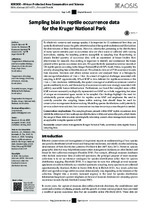Sampling bias in reptile occurrence data for the Kruger National Park
Date
2020Author
Barends, Jody
Pietersen, Darren
Zambatis, Guinevere
Tye, Donovan
Maritz, Bryan
Metadata
Show full item recordAbstract
To effectively conserve and manage species, it is important to (1) understand how they are spatially distributed across the globe at both broad and fine spatial resolutions and (2) elucidate the determinants of these distributions. However, information pertaining to the distributions of many species remains poor as occurrence data are often scarce or collected with varying motivations, making the resulting patterns susceptible to sampling bias. Exacerbating an already limited quantity of occurrence data with an assortment of biases hinders their
effectiveness for research, thus making it important to identify and understand the biases present within species occurrence data sets. We quantitatively assessed occurrence records of 126 reptile species occurring in the Kruger National Park (KNP), South Africa, to quantify the
severity of sampling bias within this data set. We collated a data set of 7118 occurrence records from museum, literature and citizen science sources and analysed these at a biologically relevant spatial resolution of 1 km × 1 km. As a result of logistical challenges associated with
sampling in KNP, approximately 92% of KNP is data deficient for reptile occurrences at the 1 km × 1 km resolution. Additionally, the spatial coverage of available occurrences varied at species and family levels, and the majority of occurrence records were strongly associated with
publicly accessible human infrastructure. Furthermore, we found that sampled areas within KNP were not necessarily ecologically representative of KNP as a whole, suggesting that areas of unique environmental space remain to be sampled. Our findings highlight the need for substantially greater sampling effort for reptiles across KNP and emphasise the need to carefully consider the sampling biases within existing data should these be used for conservation management decision-making. Modelling species distributions could potentially
serve as a short-term solution, but a concomitant increase in surveys across the park is needed. Conservation implications: The sampling biases present within KNP reptile occurrence data inhibit the inference of fine-scale species distributions within and across the park, which limits the usage of these data towards meaningfully informing conservation management decisions as applicable to reptile species in KNP

